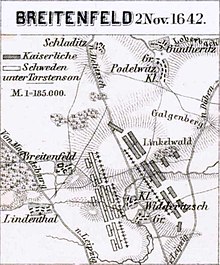Battle of Breitenfeld (1642)
| date | October 23, 1642 and November 2, 1642 |
|---|---|
| place | between Breitenfeld and Seehausen |
| output | Victory of the Swedes |
| Parties to the conflict | |
|---|---|
|
Swedish army |
Saxon-Imperial Army |
| Commander | |
|
Archduke Leopold |
|
| Troop strength | |
| 15,000 | 18,000 |
| losses | |
|
4,000 dead and wounded |
5,000 dead and wounded |
Wallerfangen - Dömitz - Haselünne - Wittstock - Rheinfelden siege - Rheinfelden battle - Breisach Siege - Witten Weiher - Vlotho - Ochsenfeld - Chemnitz - Bautzen siege - Freiberg sieges - Riebel Dorfer Mountain - Dorsten - Preßnitz - La Marfée - Wolfenbüttel siege - Kempen Heath - Swidnica - Breitenfeld - Klingenthal - Tuttlingen - Freiburg - Jüterbog - Jankau - Herbsthausen - Alerheim - Korneuburg - Totenhöhe - Hohentübingen - Triebl - Zusmarshausen - Wevelinghoven - Dachau - Prague siege
The second battle at Breitenfeld on October 23, 1642 (according to the new calendar : November 2, 1642) was a military conflict during the Thirty Years' War . A Swedish army under Lennart Torstensson defeated a Saxon imperial army under Archduke Leopold of Austria and General Piccolomini .
prehistory
The Swedish general Torstensson, who wanted to besiege Leipzig , was persecuted by the Saxon-imperial army under Archduke Leopold and Piccolomini after his summer campaign in Bohemia was broken off and brought to Leipzig. He withdrew from Leipzig to Breitenfeld , where the battle broke out.
course
The Archduke opened the attack on the Swedes with strong cannon fire, from which he hoped for cover while his troops were still gathering to attack. Torstensson realized he had to attack the outnumbered enemy forces before they could line up to fight. He had Carl Gustav Wrangel , who commanded the infantry , attack the left wing of the imperial troops , which quickly collapsed and opened the way for the Swedish cavalry . Although the imperial horsemen on the right wing had pushed back the Swedes and were already attacking their center, the Swedish cavalry now came to the aid of the center and drove out the imperial foot soldiers. Thereupon whole squadrons of the imperial cavalry threw away their weapons and surrendered to the Swedes. The Archduke himself barely escaped capture.
The Swedes lost 4,000 dead and wounded, including eight generals. The Imperial Saxon Army lost 5,000 dead and wounded as well as 4,500 prisoners and 46 cannons, 191 standards, 50 wagons with ammunition, the office with the cash register and all luggage.
consequences
After the lost battle, the Archduke dismissed all senior officers of the left wing from service for cowardice . Of these, the commander of the Cürassier Regiment Des Fours , Colonel Johann Des Fours, was later brought before a court martial and executed. He left the lower officers hanging and decimated the crew by shooting them .
The conquest of Leipzig and the occupation of Saxony by the Swedes were the next consequences of this battle; another that Emperor Ferdinand III. became more inclined to peace and not long afterwards confirmed the Hamburg Preliminary Peace .
See also
literature
- Hans Delbrück: History of the art of war in the context of political history. Berlin 1920, part 4, pp. 232-240.
- AA Evans, David Gibbson: Military History from Antiquity to Today. Bassermann Verlag 2009
Individual evidence
- ↑ CV Wedgwood: The 30 Years War . Paul List Verlag Munich 1967; Licensed edition Cormoran Verlag, Munich 1999, (p. 392f) ISBN 3-517-09017-4

